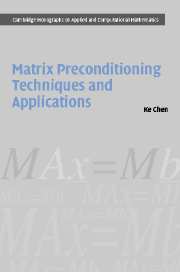Book contents
- Frontmatter
- Contents
- Preface
- Nomenclature
- 1 Introduction
- 2 Direct methods
- 3 Iterative methods
- 4 Matrix splitting preconditioners [T1]: direct approximation of An×n
- 5 Approximate inverse preconditioners [T2]: direct approximation of An×n−1
- 6 Multilevel methods and preconditioners [T3]: coarse grid approximation
- 7 Multilevel recursive Schur complements preconditioners [T4]
- 8 Sparse wavelet preconditioners [T5]: approximation of Ãn×n and Ãn×n−1
- 9 Wavelet Schur preconditioners [T6]
- 10 Implicit wavelet preconditioners [T7]
- 11 Application I: acoustic scattering modelling
- 12 Application II: coupled matrix problems
- 13 Application III: image restoration and inverse problems
- 14 Application IV: voltage stability in electrical power systems
- 15 Parallel computing by examples
- Appendix A a brief guide to linear algebra
- Appendix B the Harwell–Boeing (HB) data format
- Appendix C a brief guide to MATLAB®
- Appendix D list of supplied M-files and programs
- Appendix E list of selected scientific resources on Internet
- References
- Author Index
- Subject Index
- Plate section
11 - Application I: acoustic scattering modelling
Published online by Cambridge University Press: 06 January 2010
- Frontmatter
- Contents
- Preface
- Nomenclature
- 1 Introduction
- 2 Direct methods
- 3 Iterative methods
- 4 Matrix splitting preconditioners [T1]: direct approximation of An×n
- 5 Approximate inverse preconditioners [T2]: direct approximation of An×n−1
- 6 Multilevel methods and preconditioners [T3]: coarse grid approximation
- 7 Multilevel recursive Schur complements preconditioners [T4]
- 8 Sparse wavelet preconditioners [T5]: approximation of Ãn×n and Ãn×n−1
- 9 Wavelet Schur preconditioners [T6]
- 10 Implicit wavelet preconditioners [T7]
- 11 Application I: acoustic scattering modelling
- 12 Application II: coupled matrix problems
- 13 Application III: image restoration and inverse problems
- 14 Application IV: voltage stability in electrical power systems
- 15 Parallel computing by examples
- Appendix A a brief guide to linear algebra
- Appendix B the Harwell–Boeing (HB) data format
- Appendix C a brief guide to MATLAB®
- Appendix D list of supplied M-files and programs
- Appendix E list of selected scientific resources on Internet
- References
- Author Index
- Subject Index
- Plate section
Summary
An important class of problems in which significantly higher accuracies are needed relate to low-observable applications, where the quantities of interest are small residuals of large incident fields.
Oscar P. Bruno. Fast, high-order, high-frequency integral methods for computational acoustics and electromagnetics. Lecture Notes in Computational Science and Engineering 31. Springer-Verlag (2003)However, wavelet representation of an oscillating matrix appears to be as dense as the original, i.e. oscillatory kernels cannot be handled efficiently by representing them in wavelet bases.
A. Averbuchet al. On efficient computation of multidimensional oscillatory integrals with local Fourier bases. Nonlinear Analysis (2001)The acoustic scattering modelling provides a typical example of utilizing a boundary element method to derive a dense matrix application as shown in Chapter 1. Such a physical problem is only a simple model of the full wave equations or the Maxell equations from electromagnetism. The challenges are:
(i) the underlying system is dense and non-Hermitian;
(ii) the kernel of a boundary integral operator is highly oscillatory for high wavenumbers, implying that a large linear system must be solved. The oscillation means that the fast multipole method and the fast wavelet methods are not immediately applicable.
This chapter reviews the recent work on using preconditioned iterative solvers for such linear systems arising from acoustic scattering modelling and points out the various challenges for future research work. We consider the following.
- Type
- Chapter
- Information
- Matrix Preconditioning Techniques and Applications , pp. 383 - 399Publisher: Cambridge University PressPrint publication year: 2005



